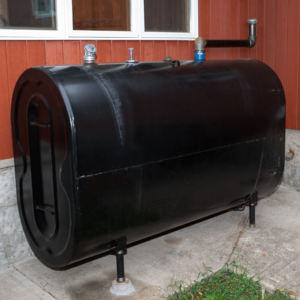Answers about your home heating oil tank.
If you’re a new home owner or just new to oil heat, you may have more than a few questions. We put together this introduction to the standard home heating oil tank, so you can get answers about oil tank basics in one place.
Residential home heating oil tanks can be found inside or outside, typically in basements and garages. These are known as above-ground storage tanks, or AST’s. Sometimes tanks are buried in the ground, these are known as underground storage tanks or UST’s. The size and shape of your tank may vary depending on the size of your home, when it was originally built or where you live.
It’s important to familiarize yourself with your tank and its parts to ensure that it is safe and properly maintained. Doing so will help prevent mishaps, leaks or other costly issues and give you a better understanding of home heating oil safety.
The tank body
The bodies of most heating oil tanks are made from 12 or 14 gauge carbon steel or plastics like polyethylene. These durable materials provide years of reliable, safe use. They can come in several styles and qualities including single wall, double wall, double bottomed and bunded. Bunded tanks have an extra exterior layer with enough space to hold the entire tank’s oil should the tank walls fail. Double walls and bottoms also help prevent leaks. Think of it as a safety provision, to prevent any spills and leaks.
The most common size tank found in the home is 275 gallons but there are a number of other sizes including 288 gallon, 340 gallon, 420 gallon and even upwards of 500 gallon tanks. Some homes use two tanks side by side piped together, instead of a larger tank.
While the size of a tank is 275 gallons, it is important to know that the actual usable capacity of that tank is less. There needs to be some air space in the tank for the fuel to expand and contract if temperatures change. The average 275 gallon tank holds about 225 gallons of fuel.
Standing tanks have attached legs designed to keep the tank off the floor or ground at least 6 inches. This can help prevent damage and wear and tear.
The tank gauge
The tank gauge is extremely important for ordering home heating oil. Typically found on the top of tanks near the mid pipe, it shows you how much fuel is currently in your tank. Standard gauges have readings of full, 3/4, 1/2, 1/4 and empty. They often have a glass vial and mechanical level for measuring the fuel inside.
Modern advancements in technology have expanded the world of tank gauges; we’re now seeing digital gauges and even smart gauges, which provide a hands off approach using an app or Alexa.
If your tank does reach empty, you’ll need to request a prime and restart, as most furnaces will go out when there is no fuel.
Fill & vent pipes
The two pipes coming off your tank are essential to its safe use. Often times these pipes travel through foundations, coming out of the side of the house or the ground.
The fill pipe is used by our drivers to fill the tank. Oil is pumped into this pipe from the fuel tuck, making its way down into the tank. As the heating oil enters the tank, air is forced up out of the vent pipe. The vent pipe vents air so that there is not pressure build up when oil is traveling in from a truck or out to your furnace or boiler.
The vent whistle
At the base of your vent pipe is a vent whistle. This ingenious valve provides a way to safely fill oil tanks without spills or overfilling accidents. While the tank is being filled with heating oil, air is forced up through the vent whistle and out of the vent pipe. This will make a loud whistle sound, alerting the driver that the tank is filling safely. Once the whistle stops, the driver knows to turn off the flow of oil. Vent whistles are designed to stop blowing just before the tank is at capacity. These whistles are often referred to as vent alarms and required by law in many places.
The shut off valve
Near the bottom of your oil tank is a manual valve known as the shut off valve. This valve connects with the oil filter and oil lines that head to your furnace or boiler. It is an important part of the system as a manual fail safe in emergencies. Similar to turning off the water when your toilet water is rising, turning off your oil can be crucial if your oil lines break or need to do repairs to your heating system. It’s also necessary to turn off the flow of oil to replace the oil filter.
The oil tank filter
Just below the shut off valve is a small canister that holds the oil tank filter. This filter prevents small particles from making its way into your oil burner, which can cause clogs or unwanted soot.
We recommend changing your oil filter annually to keep your home heating oil moving smoothly from your tank and through your oil lines. How often you actually need to change this oil filter can vary depending on your home size, oil use and the condition of your tank and equipment.
Oil lines
Beyond the tank filter are the fuel lines that lead oil into your heating system. Make sure these are in good condition and keep objects away from the lines to prevent damage and unwanted spills. Often time these lines are low to the ground, so take caution as they could be a tripping hazard.

